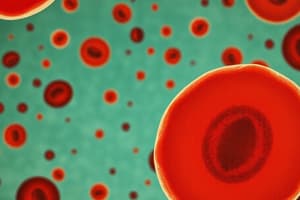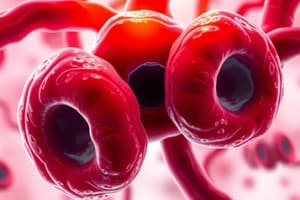Podcast
Questions and Answers
What characterizes spherocytes?
What characterizes spherocytes?
- Teardrop shape
- Presence of a central pallor
- Fragmented RBCs
- No central pallor (correct)
Which condition is associated with the presence of schistocytes?
Which condition is associated with the presence of schistocytes?
- Uremia (correct)
- G6PD deficiency
- Thalassemia
- Lead poisoning
What is a dacryocyte also known as?
What is a dacryocyte also known as?
- Spherocyte
- Spur cell
- Mouth cell
- Teardrop cell (correct)
Stomatocytes are characterized by which type of central pallor?
Stomatocytes are characterized by which type of central pallor?
What major component is increased in acanthocytes?
What major component is increased in acanthocytes?
Which condition is associated with basophilic stippling?
Which condition is associated with basophilic stippling?
What is a characteristic appearance of Heinz bodies?
What is a characteristic appearance of Heinz bodies?
Cabot rings are associated with which type of cell structure?
Cabot rings are associated with which type of cell structure?
What is the primary cause of Elliptocytes in red blood cells?
What is the primary cause of Elliptocytes in red blood cells?
Which type of red blood cell morphology is characterized by a ‘Bull's eye’ appearance?
Which type of red blood cell morphology is characterized by a ‘Bull's eye’ appearance?
What condition is associated with decreased hemoglobin synthesis resulting in microcytic anemia?
What condition is associated with decreased hemoglobin synthesis resulting in microcytic anemia?
Which of the following is NOT a result of macrocytic anemia?
Which of the following is NOT a result of macrocytic anemia?
What morphological characteristic is typical of Normocytic red blood cells?
What morphological characteristic is typical of Normocytic red blood cells?
Which type of red blood cell morphology is caused by the polymerization of Hemoglobin S?
Which type of red blood cell morphology is caused by the polymerization of Hemoglobin S?
What is a potential cause of Echinocytes, also known as crenated cells?
What is a potential cause of Echinocytes, also known as crenated cells?
Which anemia is associated with impaired nuclear maturation of red blood cells?
Which anemia is associated with impaired nuclear maturation of red blood cells?
What type of hemoglobinopathy is specifically associated with a microcytic hypochromic red blood cell morphology?
What type of hemoglobinopathy is specifically associated with a microcytic hypochromic red blood cell morphology?
Which inclusion body is associated with iron deposits in red blood cells?
Which inclusion body is associated with iron deposits in red blood cells?
How is the term 'hyperchromic' characterized in terms of red blood cell staining?
How is the term 'hyperchromic' characterized in terms of red blood cell staining?
What does rouleaux formation in red blood cells indicate?
What does rouleaux formation in red blood cells indicate?
Which parasitic inclusion is associated with Plasmodium falciparum?
Which parasitic inclusion is associated with Plasmodium falciparum?
Which condition is characterized by accelerated erythropoiesis and the presence of nucleated red blood cells?
Which condition is characterized by accelerated erythropoiesis and the presence of nucleated red blood cells?
Which condition is characterized by larger red blood cells and is typically referred to as macrocytic anemia?
Which condition is characterized by larger red blood cells and is typically referred to as macrocytic anemia?
Which of the following disorders is NOT commonly associated with hypochromic red blood cells?
Which of the following disorders is NOT commonly associated with hypochromic red blood cells?
Flashcards are hidden until you start studying
Study Notes
Red Blood Cell Morphology
- Elliptocytes: Cigar or egg-shaped; linked to RBC membrane deficiencies, especially spectrin.
- Codocytes: Known as target cells with a bull's eye or Mexican hat appearance due to large central pallor; often seen in liver diseases and hemoglobinopathies.
- Echinocytes: Crenated or burr cells with spicules; may be artificially caused during slides drying, associated with osmotic pressure changes in cells.
- Drepanocytes: Sickle-shaped due to polymerization of Hgb S; linked to decreased oxygen levels and acidic blood pH.
- Schistocytes: Fragmented RBCs associated with disseminated intravascular coagulation and microangiopathic hemolytic anemia.
Size (Anisocytosis) and Shape (Poikilocytosis)
- Anisocytosis: Variation in size; detected using peripheral blood smear (PBS), RBC indices, and RDW.
- Microcytic RBC: MCV < 80, often due to decreased hemoglobin synthesis (iron deficiency, chronic disease).
- Macrocytic RBC: MCV > 100, linked to defects in nuclear maturation (megaloblastic anemia, vitamin B12 or folate deficiencies).
- Normocytic RBC: Normal size with an average diameter of 7.2 µm; categorized as "discocytes".
Inclusion Bodies
- Basophilic Stippling: Fine to coarse granules in RBC indicating RNA remnants; appears as “blueberry bagel”, seen in lead poisoning and severe anemia.
- Cabot Rings: Loop-shaped structures from mitotic spindle remnants; noted in pernicious anemia and lead poisoning.
- Heinz Bodies: Denatured hemoglobin leading to a pitted appearance; commonly associated with G6PD deficiency.
- Howell-Jolly Bodies: DNA remnants seen in accelerated or abnormal erythropoiesis; prevalent in hemolytic and megaloblastic anemia.
- Pappenheimer Bodies: Siderotic granules made up of iron aggregates from mitochondria and ribosomes.
Hemoglobin Variation (Color) - Anisochromia
- Hypochromic: Pale RBCs larger than 1/3 central pallor; commonly observed in iron deficiency and thalassemia.
- Hyperchromic: Deeply stained RBCs, often indicative of abnormal thickness and conditions like macrocytosis or spherocytosis.
Other Cell Types
- Dacryocyte: Pear-shaped "teardrop cells"; associated with primary myelofibrosis and various anemia types.
- Stomatocytes: Mouth cells with slit-like central pallor, linked to Na+/K+ imbalances and conditions like overhydration or dehydration.
- Acanthocytes: Thorny, spicule-covered cells caused by increased cholesterol levels; associated with McLeod Syndrome and abetalipoproteinemia.
Alterations in RBC Distribution
- Rouleaux Formation: Stacking of RBCs resembling coins; often due to high protein content in serum.
- Agglutination: Irregular clustering of RBCs, often indicating an immune response or underlying pathology.
Studying That Suits You
Use AI to generate personalized quizzes and flashcards to suit your learning preferences.




